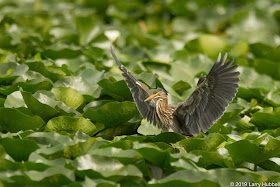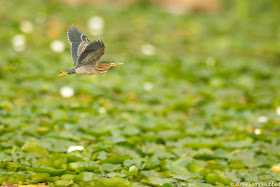The easiest way to spot a Green Heron is when they are out in the open. Before the lily pads reach full bloom, the herons are more likely to hunt from a stick or a log just above the water - often fairly close to shore.
They are most common around Union Bay during breeding season - May to October. If you are lucky, during the early part of the season, you might even see one gathering sticks to build a nest.
For me the best time to find Green Herons is from mid-August through mid-September. At which time, the primary place to find them is while hunting among the lily pads. The young are out of the nests and all family members should now be hunting for themselves. Many times, if you find the first one, and then look carefully, a second or third heron can be found somewhere nearby. Their consistent variations in color and age reinforce the idea that I am often seeing members of a single-family.
On Thursday, this young bird was hopping and leaping among the lily pads. Maybe not the best approach for catching a fish or a frog.
However, the leaping impatience of youth did seem to work at flushing up insects which it quickly consumed.
As you look at these next few photos, you might want to make mental notes of the features which indicate this is a first-year heron.
I am not sure if we should include the flapping of wings as a youthful feature but we can certainly say it is characteristic of youth.
This was the first time I remember noticing the fairly uniform gray underside to the wings.
The nearly constant movement of the young bird made it much easier to follow.
You might want to notice and compare the light-yellow color of the foot to the orange-yellow of the bill.
Previous posts, like The Secret Weapon in 2018, have mentioned the white triangles visible on the sides of the folded wings as indicators of youth. This year for the first time I noticed that a row (or two) of the triangles also appears where the wings meet the back.
The two tufts of white feathers on the head might also be an indication of youth.
The white triangles are more obvious with the wings extended. From this angle, we can also see the faint double row along the edge of the back.
Friday, I happened to see an adult Green Heron. Even from the back the differences between the two birds were striking.
The adult's movements were far more serene. There was almost no flapping of wings even though it was hunting in virtually the same type of habitat.
The adult's feathers were much richer in color. It had no white triangles. Although, there was still some nice light edging to the wing feathers.
The bill was mostly black instead of yellow. The sides of the neck lacked the vibrant white streaking of youth.
Only once, when it really needed to move quickly, did the adult raise his wings.
It is interesting to note that the underside of the adult's wing is also uniformly gray.
The adult's flash of movement and wings was immediately followed by catching a fish.
As the fish struggled the adult remained relatively motionless.
This approach is in stark contrast to Belted Kingfishers which also catch and eat fish in the same area. Before consuming a fish, kingfishers will often slam it against their perch until it ceases to resist.
The heron simply waited. It appeared to do nothing.
By the way, notice how the adult heron's legs are much more golden than the faintly yellow legs of the young heron.
Apparently, the heron was waiting for fish to twist in just the right (or wrong) direction.
With just the slightest tilt of the head, it swallowed. The whole process took just 15 seconds.
By the way, I believe this is an adult male because of the richness of the coloring. Females look very similar but are slightly more faded. This assumption was reinforced by seeing both a female and a first-year Green Heron hunting nearby.
This morning, I saw five Green Herons and two interesting episodes on Duck Bay. My key trick to finding Green Herons on the lily pads is bringing my binoculars and slowly searching every square foot.
In the first episode, one of the young herons flew at an adult (presumed) female as she was hunting. She turned the tables and chased the young one away. Apparently, as soon as they are full-sized and capable they need to be feeding themselves.
The second interaction was between a Belted Kingfisher and a young Green Heron. The heron was hunting in the shallows in an area which was apparently under one of the kingfisher's favorite perches. When the kingfisher flew up and landed it immediately began chattering non-stop. I suspect it was hoping to chase the heron away. After a few minutes, of raucous abuse the young Green Heron flew up and land on the same branch. The heron sat with its neck fully extended and stared at the kingfisher. The kingfisher quietly stared back while considering its options. After a few more moments, the smaller kingfisher 'blinked' and wisely chose to abandon the competition.
I certainly hope you get the chance to get out and watch Green Herons as they search for life among the lilies.
Have a great day on Union Bay...where nature lives in the city!
Larry
Going Native:
Without a well-funded Environmental Protection Agency, it falls to each of us to be ever more vigilant in protecting our local environments. Native plants and trees encourage the largest diversity of lifeforms because of their long intertwined history with our local environment and native creatures. I have been told that even the microbes in the soil are native to each local landscape. I hope we can inspire ourselves, our neighbors and local businesses to respect native flora and to support native wildlife at every opportunity. I have learned that our most logical approach to native trees and plants (in order of priority) should be to:
1) Learn and leave established native flora undisturbed.
2) Remove invasive species and then wait to see if native plants begin to grow without assistance. (If natives plants start on their own, then these plants or trees are likely the most appropriate flora for the habitat.)
3) Scatter seeds from nearby native plants in a similar habitat.
4) If you feel you must add a new plant then select a native plant while considering how the plant fits with the specific habitat and understanding the plant's logical place in the normal succession of native plants.
My intention in my weekly post is to include at least one photo each week and visually challenge us to know the difference between native and non-native lifeforms.
1) Learn and leave established native flora undisturbed.
2) Remove invasive species and then wait to see if native plants begin to grow without assistance. (If natives plants start on their own, then these plants or trees are likely the most appropriate flora for the habitat.)
3) Scatter seeds from nearby native plants in a similar habitat.
4) If you feel you must add a new plant then select a native plant while considering how the plant fits with the specific habitat and understanding the plant's logical place in the normal succession of native plants.
My intention in my weekly post is to include at least one photo each week and visually challenge us to know the difference between native and non-native lifeforms.
Are these dragonflies native to Union Bay?
Scroll down for the answer.
***************
Yes. Both of these are native to Union Bay.
***************
The Email Challenge:
Over the years I have had many readers tell me that Google is no longer sending them email announcements regarding my posts. Even more frustrating when they go to 're-sign-up', hoping that will enable them to once again start receiving the announcements, they get a message which says 'Sorry, you are already signed up.' Google has not responded to my requests for help with this issue.
My functional workaround is to set up my own email list and each week I manually send out a new post announcement. If you are experiencing the issue and would like to be added to my personal email list please send me an email requesting to be added. Thank you for your patience!
My email address is LDHubbell@comcast.net




































































